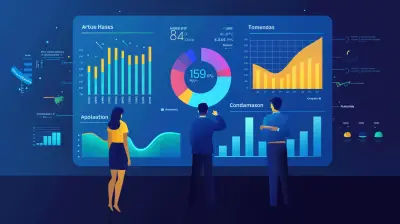How Behavioral Science Can Improve Risk Management Decisions
20 June 2025
Let’s be real—when you hear “risk management,” your brain probably drifts off into a sea of spreadsheets, compliance jargon, and corporate safety nets. But what if I told you that the secret sauce to smarter decisions around risk isn't always data or formulas—it's people? Yep, behavioral science can play a huge role in how businesses identify, assess, and respond to risk.
In this article, we’ll break down how behavioral science—the study of human behavior—can level up your risk management game. Whether you're navigating financial risks, operational hazards, or strategic uncertainties, understanding human behavior can be your best ally (and sometimes your biggest blind spot).
What Is Behavioral Science, Anyway?
Before we dive into how it improves risk management, let’s quickly define what behavioral science actually is.Behavioral science is a field that explores how people really behave rather than how they should behave. It pulls from psychology, economics, sociology, and even neuroscience to understand what drives human decision-making.
For example—you know that feeling when you buy something, not because you need it, but because it was “on sale”? That’s behavioral science. We’re all influenced by biases, emotions, social pressure, and habits. And guess what? These same influences affect how people make decisions about risk.
Why Traditional Risk Models Fall Short
Most traditional risk management models are designed assuming that people are logical actors. Like robots. But spoiler alert—we’re not. Ever heard of FOMO? Or gut decisions?Here are a few ways traditional models miss the mark:
- They overlook human error — People make mistakes. Duh.
- They don’t account for emotional responses — Fear, overconfidence, anxiety—all these change how we perceive risk.
- They assume rationality — But decision-making is rarely 100% rational.
So, if your model doesn’t include the way humans really behave, it’s like planning for sunny weather in a storm.
Cognitive Biases: The Silent Risk Saboteurs
Let’s talk about cognitive biases. They’re unconscious mental shortcuts that influence decisions... and not always for the better.1. Overconfidence Bias
You think you're better at predicting outcomes than you really are. This can lead to underestimating risks or skipping due diligence.2. Confirmation Bias
You seek out information that supports what you already believe. Risk assessments can get skewed this way—big time.3. Anchoring Bias
Ever made a decision because the first piece of info you got “stuck” in your brain? That’s anchoring. It limits perspective and flexibility.4. Loss Aversion
People hate losing more than they love winning. This can cause overly conservative decisions or missed opportunities.In short? These biases lead to flawed choices, even when we're trying to be smart about risks.
So How Does Behavioral Science Actually Help?
Great question. Behavioral science doesn’t just point out flaws—it gives us tools to deal with them. When applied to risk management, it offers insights and techniques that help teams make more informed, more human-aware decisions.1. Improving Risk Perception
People perceive risk differently. You might see a situation as dangerous, while someone else sees it as an opportunity. Behavioral science helps identify what’s shaping those perceptions—fear, past experiences, incentives—and corrects for them.2. Designing Better Decision Frameworks
By recognizing how decisions are influenced, companies can redesign processes to nudge better choices. Think of it like adding guardrails to a winding road—people still drive, but it’s safer.For example:
- Use checklists to combat decision fatigue.
- Build in 'pre-mortem' analyses to challenge assumptions.
- Run scenario planning exercises to prepare for uncertainty.
3. Creating Feedback Loops
Humans learn best with timely feedback. Behavioral science encourages systems where teams get real-time data on the outcomes of their decisions. This builds awareness and improves future decision-making.Real-World Examples: Behavioral Science in Action
Let’s zoom in on how behavioral science is already shaking up risk management across different industries.Financial Services
Banks and investment firms are known for managing risk. But even a data-heavy industry like finance isn’t immune to human error (remember the 2008 crisis?).Behavioral finance now plays a role in helping investors avoid knee-jerk reactions to market dips, thanks to tools that flag emotional trading or biased analysis.
Healthcare
In hospitals, snap decisions can literally mean life or death. By training teams to recognize decision fatigue or confirmation bias, outcomes improve. Even simple changes—like how options are presented in a software interface—can reduce medical errors.Cybersecurity
You can have all the right firewalls, but if an employee clicks on a phishing link? Boom. Understanding why people fall for scams (urgency, fear, reward) helps build smarter training and safer behaviors.Aviation
Pilots are trained extensively using behavioral psychology—especially around communication and error management. CRM (Crew Resource Management) came from this kind of research and drastically reduced fatal accidents.Creating a Risk-Smart Culture: The Human Factor
Here's something you won't solve with spreadsheets: culture. A company’s culture heavily influences how risks are reported, discussed, and managed. If people are afraid to speak up, or if mistakes are punished harshly, you're likely flying blind.Behavioral science suggests the opposite approach:
- Normalize open dialogue about risks.
- Encourage dissent—smart risk decisions often come from hearing different viewpoints.
- Reward transparency, even when the news isn’t great.
In other words, make it safe to be honest.
Nudging Better Decisions (Without Being Creepy)
“Nudging” is a fun concept in behavioral economics. It’s about gently guiding people toward better choices without restricting freedom.For risk management, that could mean:
- Changing how options are framed (e.g., 90% chance of success sounds better than 10% chance of failure).
- Highlighting past outcomes to inform future thinking.
- Setting defaults that support low-risk behavior (e.g. automatic data backups or opt-in safety measures).
It’s not manipulation—it’s smart design.
Using Behavioral Data for Predictive Risk Models
Now we’re getting high-tech. As more companies collect behavioral data—like how employees interact with systems or make decisions—this info can feed into predictive models.Imagine being able to predict a compliance breach based on communication patterns or decision trails. That’s the potential here. But it has to be managed ethically, with transparency and consent.
Training and Development: Thinking Beyond the Basics
Traditional risk training often boils down to: “Here’s what to do, don’t mess it up.” Not super engaging, right?Behavioral science encourages training that:
- Simulates real-life pressure
- Offers immediate feedback
- Explores emotional reactions to uncertainty
It’s about building judgment, not just knowledge. You can’t memorize your way out of a crisis—but you can train your brain to stay calm, think critically, and act wisely.
Common Pitfalls to Watch Out For
Even when using behavioral science, it’s not all smooth sailing. Here are a few traps to avoid:1. Thinking One Size Fits All
People process risk differently. One strategy might work for some but backfire with others.
2. Overcomplicating the Process
Behavioral insights are powerful, but don’t turn every risk discussion into a psychological experiment.
3. Ignoring Ethics
Improving decisions is good. Manipulating people is not. Always aim for transparency and fairness.
Final Thoughts: Thinking Like a Human, Not a Machine
At the end of the day, risk management isn’t just about avoiding worst-case scenarios—it's about making better choices in complex, uncertain environments. And because humans are the ones making those choices, behavioral science gives you a huge leg up.By understanding how our brains work (and how they don’t), businesses can build systems that not only handle risk better but do so in a way that’s sustainable, ethical, and—most importantly—real.
So next time you're facing a big risk decision? Don't just crunch the numbers. Check in with the humans behind them.
all images in this post were generated using AI tools
Category:
Risk ManagementAuthor:

Caden Robinson
Discussion
rate this article
2 comments
Mackenzie King
Great insights! Leveraging behavioral science in risk management can truly transform decision-making processes. Embracing this approach not only enhances strategies but also fosters a proactive culture in organizations. Keep up the good work!
November 16, 2025 at 3:33 AM
Viva Stone
This article offers valuable insights into integrating behavioral science with risk management. Understanding human behavior is crucial for making informed decisions in today's complex landscape.
June 20, 2025 at 4:50 AM

Caden Robinson
Thank you for your feedback! I’m glad you found the insights valuable; integrating behavioral science is indeed essential for effective risk management.


